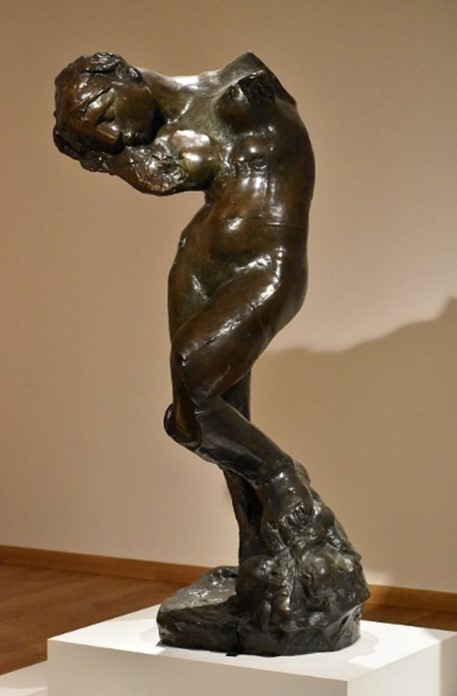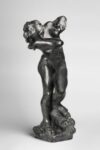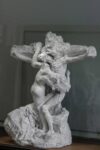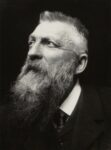


Auguste Rodin
French, 1840-1917
The Inner Voice or Meditation Without Arms, 1896-1897; cast 2017
Bronze
21.25 x 7.5 x 6.25 in.
SBMA Purchase, Ludington General Acquisition Fund
2019.29

Francois August Rene Rodin photograph by George Charles Beresford, 1902
“The human body is first and foremost a mirror to the soul and its greatest beauty comes from that.”
“My figure represents ‘Meditation.’ That is why it has neither arms to act nor legs to walk. Haven’t you noticed that reflection, when persisted in, suggests so many plausible arguments for opposite directions that it ends in inertia?” - Auguste Rodin
RESEARCH PAPER
“The Inner Voice or Meditation Without Arms” is the final version of a much-revised and adapted work. Its history illustrates Rodin’s evolution from conventional representation of the human form to his art and practice of naturalistic depiction, amplification, and fragmentation of form. This work challenges the viewer to observe and incorporate their own emotion and intuition into the work.
“Damned Woman” originally appeared as one element in the upper right tympanum of “The Gates of Hell,” a work that was never completed or cast in Rodin’s lifetime. The figure, in high relief (emerging from the background), was identified as a soul in torment, and appeared to be a hybrid of a female torso and male limbs.
In 1885, Rodin created a larger free-standing version initially titled “Meditation” and later, alternately, “The Inner Voice.” The latter was inspired by an 1837 Victor Hugo poetry collection, “Les Voix Intérieures (Interior Voices).” In 1894, Rodin reworked the sculpture and used it to portray Mary Magdalen in “Christ and the Magdalen,” one of his few religion-themed creations.
The ultimate version of the sculpture, “Meditation (or The Interior Voice)” is included as a figure in “Monument to Victor Hugo” (commissioned by the French state in 1889 and displayed as a plaster model at the 1897 Salon) appearing as one of the writer’s muses. This incarnation was considerably altered from previous ones, showing the Muse as though its arms had been torn off and significant portions of both legs crushed or amputated to accommodate its presence in the monument.
The 2017 (diminutive) version of “Inner Voice” was issued in a limited casting celebrating the centenary of Rodin’s death. The female figure stands in an exaggerated contrapposto pose, shoulders bent at an extreme right-tending angle, head drooping and face looking directly down at the ground. Her arms are not present, her torso is torqued back. Weight is born on the right leg and the left thigh juts forward at an obtuse angle, left foot resting on a rock. The legs exhibit internal construction—flesh stripped away, uncovering a naked ball joint at the left knee and exposed raw musculature in both legs.
The bronze surface seems almost creamy; nonetheless, texturally, it appears rough, reflecting the confused emotion that a muse can impart. The back, buttocks and legs (to the extent they exist) are heavily muscular and naturalistic, even impressionistic in presentation. Torment and uncertainty imparted in the original “Gates of Hell” rendering carry through to this version. Shadow plays against light. Clearly visible seams (the result of the lost wax method of casting) impart a quickly constructed quality. Though a small sculpture, under lights, its cramped stance, textured surface, and tortuous and converging angles create a diverse set of tonalities, suggesting a confused and complex inner voice.
Auguste Rodin was the second child born into a middle-class family in Paris. His father worked for the Prefecture of Police where he eventually became an Inspector. Rodin had a close and loving relationship with his older sister, Maria, but was a shy child and a disinterested student (possibly exacerbated by poor eyesight). His primary memory of his youth is that he enjoyed drawing. At age 14 he enrolled in the Petite École, focusing on drawing and reproducing artworks from the 18th century. Despite three attempts, he was unable to pass the entrance exam for École des Beaux-Arts, which led to a four-year stint as a bricklayer and modeler for building contractors. Disconsolate over his sister’s death in 1862, he took holy orders with Les Pères du Saint-Sacrément. When he produced an excellent bust of the order’s founder, he was advised to follow his true calling—art.
After leaving Les Pères, Rodin joined L’Union Centrale des Arts Décoratifs, rented his first studio in Paris, and while working for the sculptor Albert Carriere-Belleuse, took animal and human anatomy courses. His first Salon submission (in 1864) was refused. Until 1875 he continued working in decorative arts and taking on small sculpture commissions, whereupon he determined to truly launch his art career by creating a life-size sculpture of a male nude, “The Age of Bronze.” The sculpture was displayed in Brussels and the Paris Salon, and in both instances owing to the exquisitely beautiful and realistic rendering, Rodin was accused of surmoulage—creating a work from a live cast. Though not specifically known, it is posited that the monumental size of nearly all his works springs from the desire to disprove those misguided accusations.
Rodin’s monumental talent, energy, proclivity for expressing his aesthetic philosophy, and exceptional productivity guaranteed that he would be a giant in many areas of the visual arts. In addition to sculpture, he was a prolific producer of two-dimensional art—painting, drawing, lithography, and dry point, among others.
Rodin attracted students of sculpture from throughout Europe and the Americas, and his work was in the collections of individuals, institutions, municipalities, and countries in all those geographies during his lifetime. Shortly before his death, he agreed to bequeath his lifetime of work (approximately 15,000 pieces, 7,000 of sculpture and 8,000 two-dimensional works), along with his Paris studio/residence to the French state in exchange for a guarantee that it would become the Musée Rodin in perpetuity. Though his popularity waned following his death, in the 1950’s and 1960’s there was a resurgence of study of his oeuvre. Today he is considered the single most influential sculptor since Michelangelo.
Prepared for the Santa Barbara Museum of Art Docent Council by Gretchen Hewlett, 2025.
BIBLIOGRAPHY
Corbett, Rachel. (2016). “You Must Change Your Life: The Story of Rainer Marie Rilke and Auguste Rodin.” W.W. Norton & Company.
de Roos, H. (1992). “Rodin’s Approach to Art: The Intentional Fragment.” Retrieved January 21, 2025. www.rodin-web.org.
de Roos, H. (1992). “Rodin Works: Meditation, The Inner Voice.” Retrieved January 21, 2025. www.rodin-web.org.
Hale, W. H. (1969). “The World of Auguste Rodin, 1840-1917.” Time-Life Books.
Musée Rodin website. www.musee-rodin.fr.
Schjeldahl, Peter. (September 25, 2017). “The Stubborn Genius of Auguste Rodin.” The New Yorker Magazine.
